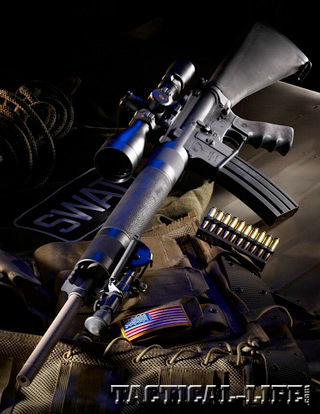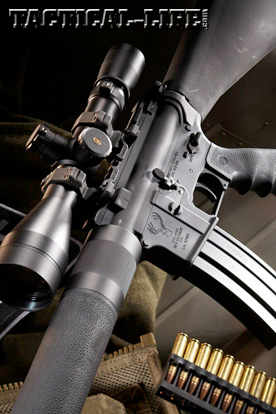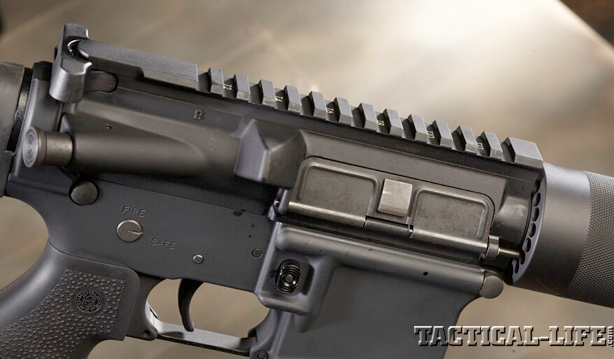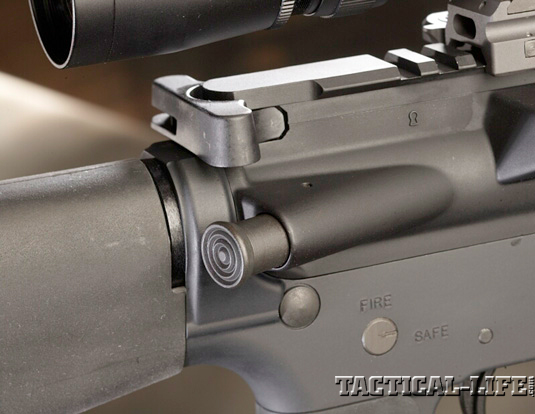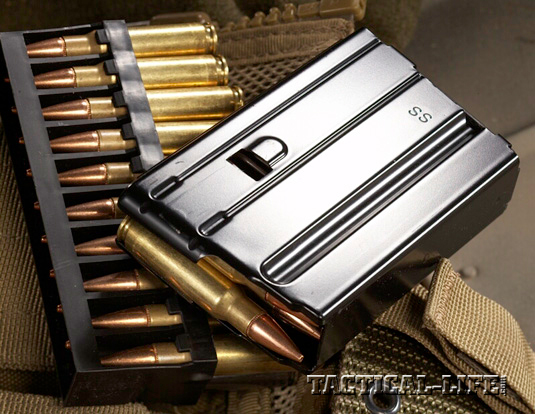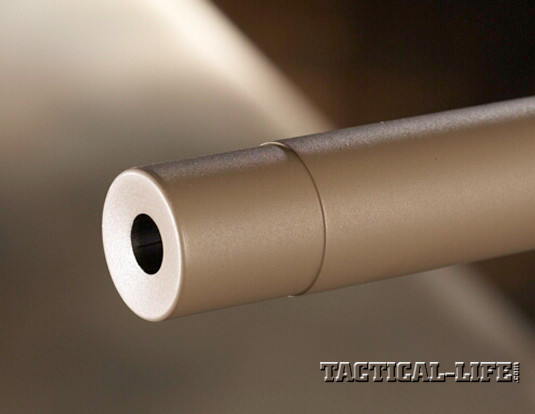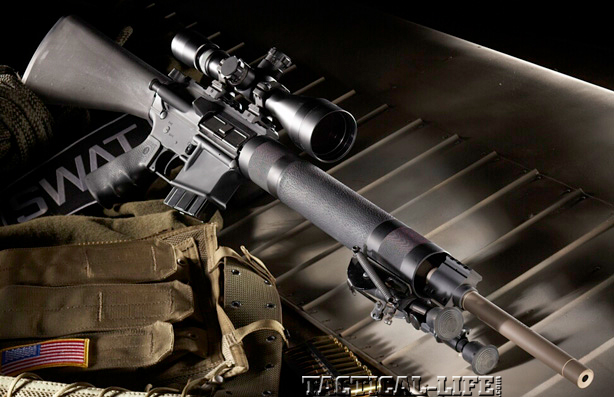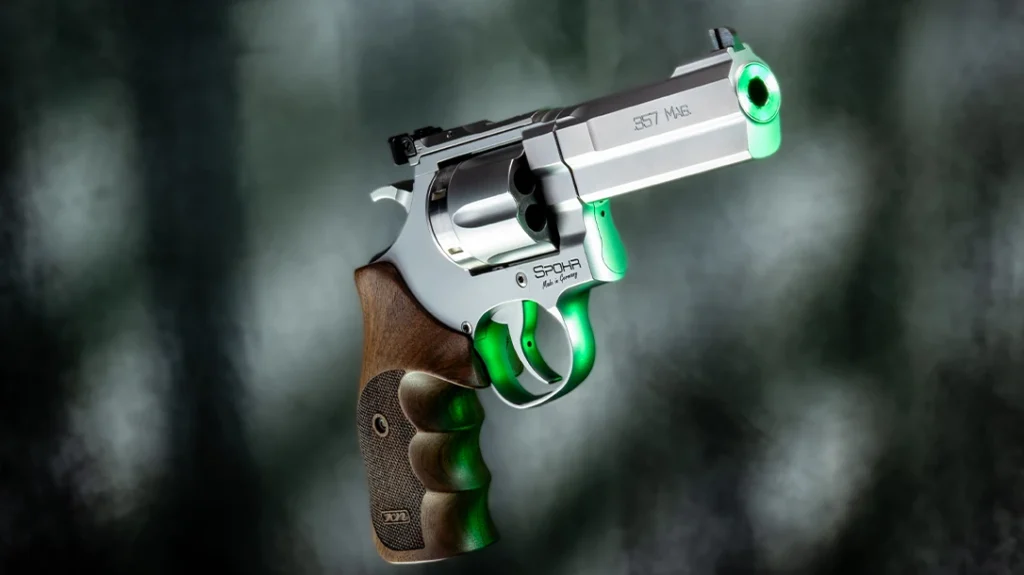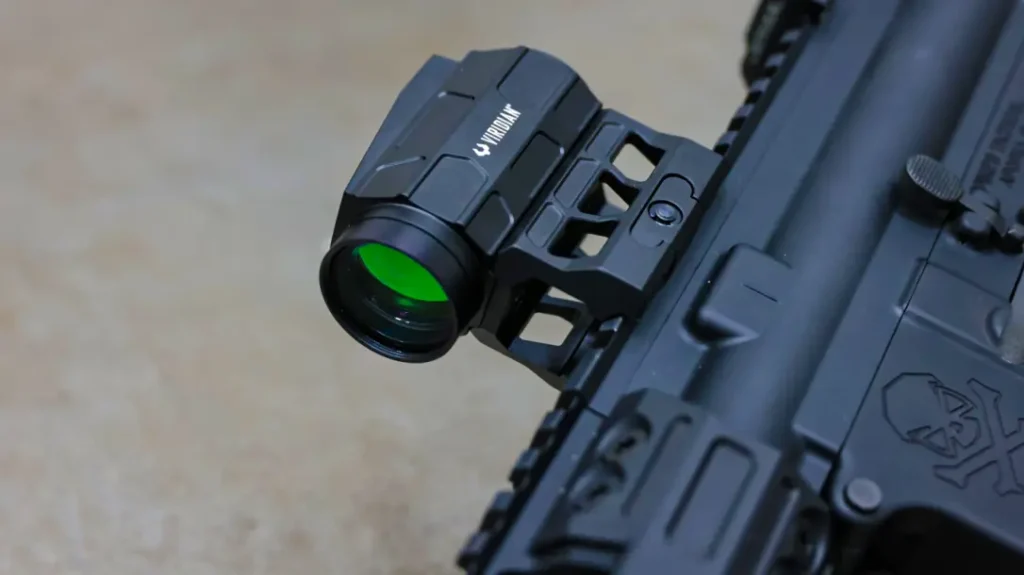Stag Arms Model 7 and Model 7L (left-handed model) are the latest editions to their catalog of innovative AR configurations. The significance of Stag’s left-handed systems has already been reviewed to great length so I am not going to spend more time covering old news. What is significant is the fact that this rifle doesn’t look like the modern battle rifle. It closer resembles the 5.56mm NATO M16A2 that most of our troops initially carried into the current War on Terror. It features a stainless steel barrel measuring 20.77 inches (like an M16A2), a cylindrical forend, an A2-style fixed buttstock and pistol grip. Looks are deceiving. To start, the pistol grip and forend are from Hogue. It’s a good choice, as Hogue integrates their OverMolded technology to produce a comfortable lightweight rubber grip and forend combination. Like the M16A2, this grip sports finger grooves but, unlike the A2, the Hogue has palm swells. The free-floating forend is a unique two-piece OverMolded aluminum tube with a tactile gripping quality that insulates the support hand from any heat that’s produced during rapid fire. The free-floating characteristic ensures that unnecessary stress to the barrel is eliminated, thereby optimizing accuracy potential. For testing, I attached a Harris bipod to the forend’s eyelet stud under the handguard, near the gas block.
The two-stage trigger group is a match quality assembly. In this case, the term “match” does not suggest a pull weight measured in ounces but one set for heart-pounding critical situations. This trigger group produces predictable take-up and pull weight, shot after shot. The wide-engagement-surface semi-disconnector and tight-fitting trigger pin ensures that the Model 7 won’t malfunction. In fact, I couldn’t get anything to rattle in the lower receiver that could lead to improper wear and unintended consequences.
Up top, the flattop upper receiver carries a Picatinny rail with six reference marks for repeated placement of most tactical optics. The Model 7 is well prepared for back-up sights utilizing the flattop and railed gas block. Pull out the M16A2-style bolt carrier group and there are a few noticeable differences. First, the slot behind the bolt carrier key just above the firing pin channel is cut flush to the rear of the key. Second, an additional gas port is drilled through the right side of the carrier bleeding excess gas and carbon fouling out the ejection port. Lastly, the bolt face is noticeably larger, ready to accept a freshly chambered 6.8 SPC cartridge. A mark atop the bolt body designates this bolt is exclusively “6.8.”
Advertisement — Continue Reading Below
Increased firepower comes from the 6.8 SPC cartridge that feeds the Model 7. A four-groove rifled barrel coated with a custom S7 finish (tan) turns a fired bullet speeding at more than 2550 fps (feet per second) with a 1-in-11-inch twist rate, accurately stabilizing the 110-grain loads. The non-reflective finish serves a tactical purpose as well as sealing the barrel from corrosion. An 11-degree crown at the muzzle ensures that field use of the Model 7 won’t impact the 6.8’s performance.
Shooting Impressions
This test was put together in a hasty effort to bring a first look at Stag’s latest entry in the world of AR tactical rifles Mild temperatures were accompanied by 20-mph winds and rain. Ammunition was limited to Hornady 110-grain TAP (Tactical Application Police). For these reasons the test results were developed from cover at the 100-yard line.
Advertisement — Continue Reading Below
Settling in at the bench, my length of pull exceeds that allowed by the Model 7’s fixed A2 stock. Shooting from the standing, kneeling, sitting or prone positions presented no issues. In fact, I particularly liked the stock, as it presents a stock-weld familiar to me. Even so, no two shooters are alike and many in uniform would prefer an adjustable stock.
After firing sight-in shots to dope in the rifle and get myself in the right frame of mind, I continued to fire nine other 5-shot groups. I cranked the Leupold to 14x magnification allowing me to accurately place the Mil-Dot reticule in the center. I leaned into the rubber bipod feet while hooting from a benched position. The first thought that crossed my mind was the felt recoil, or lack thereof. Even though this rifle checks in at a weight less than 7 pounds, it feels similar if not less of an impulse than the smaller 5.56mm NATO counterpart. Maybe it was my position. Maybe it was Stag’s platform. If the military is still considering the adoption of the 6.8 SPC, recoil isn’t a factor against it.
The hardest thing for someone doing an accuracy test with intermittent wind gusts is to have patience. Locking down the Model 7 and waiting for the wind to settle between each shot made for a long day on the range. My worst group at 100 yards was measured center-to center at 1.92 inches. Considering that my best group was measured at 0.47 of an inch and a Best 5 average of 0.70 of an inch, my ability to accurately time each shot with the wind was not entirely possible. A gross average of nine 5-shot groups measuring 1.08 inches is nothing to turn away from. The rifle and this cartridge are very capable of exceeding the military’s standards for combat accuracy.
Advertisement — Continue Reading Below
To settle an ongoing debate among my peers about repeatable POA/POI (point-of- aim/point-of-impact), I turned the ARMS throw levers and removed the Leupold. Using the Stag’s marks between Picatinny rails on top of the receiver, I reattached the scope and locked down the rings. A subsequent test fire produced the same POA/POI results. This only raised another question. What would happen if we shifted the scope and rings into a different slot along the upper receiver’s optic rail? Click off safe and fire. Same result. The tolerances of the rails proved well within spec. If I was in a hurry to slap on a scope and didn’t lock it down in the right location, combat accuracy could still be achieved with this rifle and these rings.
The Model 7 endured no malfunctions. Improvements? I want a high-capacity magazine. The one supplied only holds 5 rounds. I shot rapidly through the 5-round magazine and reloaded as fast as I could, but function testing isn’t the same without a high-capacity magazine. Although it functioned flawlessly, I know that the curvature of the AR-style magazine challenges engineers for reliable feeding. So I want to know that the rifle I deploy with would come with a reliable high-capacity feeding device.
Final Notes
Advertisement — Continue Reading Below
The Stag Arms Model 7 may appear as a regression in the tactical scene to a simpler rifle without gadgets. However, after considering what utility it offers, this Stag reminds me how contorted a straightforward design can get. I can’t think of many gadgets that would justify the need to me for a quad-rail, so the Hogue free-float tube makes a lot of sense to me. I like the power factor of a cartridge larger than the 5.56 NATO and the commonality of parts in a rifle destined for a high-threat environment. This 6.8 SPC-chambered rifle is a simple remedy for effective marksmanship on the battlefield or in support of LE operations. It’s accurate. It’s hard-hitting. It’s the new Model 7.
